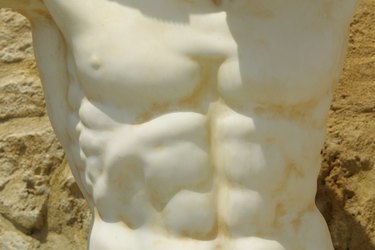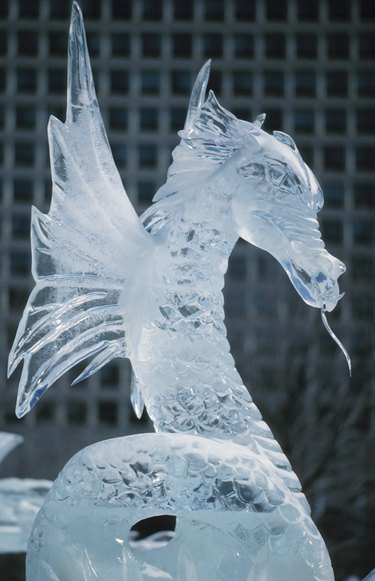
Classic methods of sculpting usually call for clay, marble, wood or bronze; however, any durable material can be used. Some of the more exotic materials used are fabrics, glass and even ice. Some materials that never find their way into the actual finished piece of art still play a critical role. Materials like sand or wax, used in the casting process for metals, are a prime example of supporting materials; without which, making the final work of art would be difficult, if not impossible.
Stone
Video of the Day

Stone is a very challenging sculpting material, one false stroke of the hammer on the chisel and the entire statue is left permanently marred or even ruined. Given the cost of working stone and its unforgiving nature, most people will take a class at a local art college before attempting their first major stone work. On a positive note, stone is famous for its ability to endure the ages; high quality stone sculptures can command impressive prices.
Video of the Day
Metal Sculpting

The most famous metal for sculpting is bronze, which is most often cast using the wax replacement method. Wax replacement in its simplest form uses a sand mold over a carved wax sculpture, complete in its own right. The molten bronze is poured into the mold, causing the heat of the metal to melt the wax, which runs out of an escape channel. The sand cast sculpture is then cooled, cleaned and polished or given a patina. There is an entire sub-art of giving bronze the perfect patina. Different combination of chemical treatments result in different color shades, which can drastically alter the mood of a work of art, creating the patina. A patina can also be created by natural aging.
Sculpting with iron and steel has become more common as the price and quality of modern welding equipment makes working these harder metals less troublesome. Industrial art pieces made of stainless steel have become common place since the 1980s, however isolated examples have existed since long before that.
Clay

Clay is a long standing favorite of sculptors, since it can be worked using either a reductive method in a fashion similar to carving, or built up using an additive method, where separate pieces are bonded before firing the item in a kiln to fix the final shape. Sculptors often also use unfired clay to make working models to consult while carving larger items.
Other Materials

Glass is a popular sculpting material for those with the proper training. Unfortunately, glass has rather high-end shop facility requirements, making it somewhat inaccessible outside of art colleges and professional studios. Organic materials like wood are popular as base materials for folk art applications, which isn't to say that hardwoods can't be used for making high class sculptures as well. Wood is ideal for use with lacquers, making it extremely versatile in the variety of effects it can convey. Ice sculpting is an often unsung sculpting material due to its ephemeral nature; however, it is very beautiful in the correct application and plays a major role in the annual Quebec City Winter Carnival in Canada, as well as the the Ice Hotel located in Jukkasjärvi, Sweden.